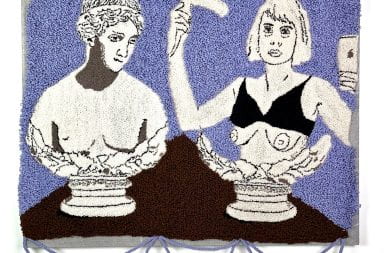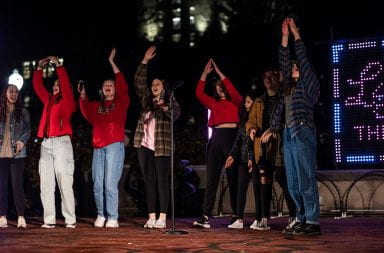With the hashtag “#OscarsSoWhite” trending for weeks on various social media platforms, and the controversy surrounding the racial dynamics of the new Broadway musical, “Hamilton,” the topic of minority representation in the entertainment industry is under harsh criticism and reform.
It’s not Hollywood, but similar challenges in racial controversy present themselves on Ohio State’s campus as Off The Lake Productions gears up for its upcoming musical, “Hairspray,” opening this weekend in Hitchcock Hall.
“We figured there would be backlash,” said Adam Adams-Grooms, president of OTL. “We didn’t want to portray a false image for this show, but especially coming from our last spring musical, Legally Blonde, demographically, OTL was really, really white.”
Adams-Grooms, a fourth-year in romance studies, described how he, along with OTL director Taylor Koon, a fourth-year in communication, had hoped to address diversity issues within the group when the pair proposed “Hairspray” for this spring’s musical.
Set amid the height of Baltimore’s civil rights activism in the 1960s, Hairspray follows a “pleasantly plump” teenage girl named Tracy Turnblad, who has dreams of being a celebrity dancer on a local television show. While Tracy doesn’t see the size or the skin color of her black peers as means to discriminate, she finds herself at the forefront of a racial and social fight for change in her town.
Playing the role of Tracy is Rachel Dummermuth, a fourth-year in pharmaceutical sciences.

Rachel Dummermuth, who is portraying Tracy Turnblad, rehearses with the rest of the cast of Off the Lake production’s “Hairspray.” Credit: Courtesy of Ogonna Ononye
“Being heavy set is an issue and a theme in the show and Tracy is oblivious to it. She’s oblivious to body image, race. She sees people as who they are and not for their physical appearance,” Dummermuth said.
Imani Davis, a second-year in film studies and member of the ensemble, agrees regarding the intent of Tracy’s character.
“It’s all about her trying to do what’s right in this world and implement this new idea of equality, that everyone is beautiful and talented and should live their dreams,” Davis said.
But with the fight for equality comes the struggle of marginalized communities being targeted, very personal situations we see in our society today. To address these issues, OTL executive board members held characterization workshops with the cast during certain rehearsals to navigate how historical and social contexts of the show affect each of the actors portraying these roles.
“When you first think of Hairspray, you think of the upbeat music, the bright colors, the big hair, but it’s so much deeper,” Koon said. “Some themes are very personal to cast members and they are able to share that with the audience.”
This sentiment struck a chord with Tre Reese, a 2015 OSU theatre alumni as he described his personal connection to his character, Seaweed J. Stubbs, the easygoing “ring-leader” of the black community who’s faced with the taboo of an interracial relationship.
“This hits very hard for me because I am mixed (race),” Reese said. “If something like that had happened back then, it would be illegal for me to exist. Some people still look twice when they see an interracial couple, but to know people in the past stood up for things like this really inspires me.”
Dummermuth said she could relate to the conflicts of her character as well.
“I get self conscious wearing the fat suit and it’s not even my body,” she said. “I think to myself, ‘Tracy is confident and I need to exude that confidence on stage and off stage,’ because if not, she completely loses her character altogether.”
Choreographer and fourth-year in neuroscience, Odette Gutierrez del Arroyo Perez, spoke to how the characterization workshops alleviated tensions among the group when discussing issues of race.
“Segregation is a prominent theme of the show so we had to talk about it and we had to do it to make it a thing to stand against it,” Gutierrez del Arroyo Perez said.
OTL will bring these deeper conversations from behind the scenes to light in an interactive workshop in Hitchcock 035 called “Run and Tell That,” at from 8-9 p.m. on March 4. Audience members are encouraged to participate in these discussions and activities facilitated by speakers in Involved Living organizations —which are focused on diversity and inclusion issues— to make broader connections to our society today.
“The same issues are still as present in 1962 as they are now, and the Black Lives Matter movement resonates with that,” Reese said. “It’s showing the backbone of that community. They’re saying we have a voice, we deserve a voice, and we are actually going to speak on what we believe in.”
Having overcome technical challenges, racial dynamics, and personal conflict throughout the process, the cast of OTL hopes to leave the audience with more than just a beat they can’t stop tapping to.
“Representation is so important,” Adams-Grooms said. “Theatre is a social tool, and this show is energetic and over the top, but it’s supposed to spark this kind of dialogue when you leave.”
OTL will perform “Hairspray” in Hitchcock Hall 131 on Friday and Saturday at 8 p.m., with a Saturday matinee at 2 p.m. The show will continue the following weekend on March 4 at 9:30 p.m., and March 5 at 4:30 p.m. and 8 p.m. Admission is $1 — which will be donated to A Kid Again, an organization benefiting children with serious illnesses — or one canned good to be donated to the Mid-Ohio Foodbank.


